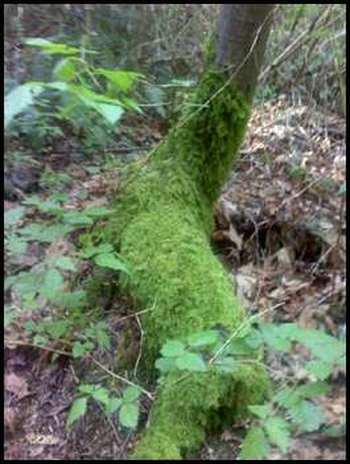The Moss

The Moss
Cloth woven of rainy days
Lime green softness
Carpet the woodlands
Jacket tree trunks
Muffle discord
No discussion of a walk in the Northwest woods is complete without mentioning the moss. The chartreuse, yellow green spores to mild green cling to just about every type of tree. They are the badges of survival in this moist, maritime climate. The woods can remain cool and damp even through the hot days of August and September, so the moss enjoys its nestling on the barks of the tree trunks. Sometimes that adage of looking for north by looking at the moss on a tree may be particularly confusing in the Northwest. Moss seems to go completely around the trees, thicker in grooves, rather than any given direction.
Moss has healing qualities for wounds. Perhaps that is the secret of longevity among the cedars and firs. The moss has been busily healing nicks and bruises as the trees grow into old age. Sometimes they cling to the lower portions of the trees and other times they seem an integral part of their height. The moss and trees have developed a pattern of working well together, symbiotic. In the rainforests of the tropics, all different types of mosses emerge. The moss of the Northwest appears more uniform, more selected to the cold and continuous damp in which they thrive. They help to cushion sounds, too, when underfoot. Healers and listeners, they steal into crevices and crannies, covering the woods with softness.
“Give me the man who will surrender the whole world for a moss or a caterpillar, and impracticable visions for a simple human delight.”
-Bruce Frederick Cummings
Enjoying Life and Other Literary Remains,'Crying for the Moon'.
Cloth woven of rainy days
Lime green softness
Carpet the woodlands
Jacket tree trunks
Muffle discord
No discussion of a walk in the Northwest woods is complete without mentioning the moss. The chartreuse, yellow green spores to mild green cling to just about every type of tree. They are the badges of survival in this moist, maritime climate. The woods can remain cool and damp even through the hot days of August and September, so the moss enjoys its nestling on the barks of the tree trunks. Sometimes that adage of looking for north by looking at the moss on a tree may be particularly confusing in the Northwest. Moss seems to go completely around the trees, thicker in grooves, rather than any given direction.
Moss has healing qualities for wounds. Perhaps that is the secret of longevity among the cedars and firs. The moss has been busily healing nicks and bruises as the trees grow into old age. Sometimes they cling to the lower portions of the trees and other times they seem an integral part of their height. The moss and trees have developed a pattern of working well together, symbiotic. In the rainforests of the tropics, all different types of mosses emerge. The moss of the Northwest appears more uniform, more selected to the cold and continuous damp in which they thrive. They help to cushion sounds, too, when underfoot. Healers and listeners, they steal into crevices and crannies, covering the woods with softness.
“Give me the man who will surrender the whole world for a moss or a caterpillar, and impracticable visions for a simple human delight.”
-Bruce Frederick Cummings
Enjoying Life and Other Literary Remains,'Crying for the Moon'.
